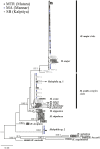Genetic identification and hybridization in the seagrass genus Halophila (Hydrocharitaceae) in Sri Lankan waters
- PMID: 33062439
- PMCID: PMC7532775
- DOI: 10.7717/peerj.10027
Genetic identification and hybridization in the seagrass genus Halophila (Hydrocharitaceae) in Sri Lankan waters
Abstract
Seagrasses, as marine angiosperms, play important roles in coastal ecosystems. With increasing anthropogenic impacts, they are facing dramatic declines on a global scale. Halophila is well-known as a complex taxonomic challenge mainly due to high morphological plasticity. By using only a morphological approach, the genus could be over-split or similar species could be erroneously lumped, thus masking its true biodiversity. In the present study, we incorporated genetic identification with morphological examination to reveal the identity of Halophila plants in southern and northwestern Sri Lankan waters. The nuclear ribosomal internal transcribed spacer (ITS) region and chloroplast ribulose-bisphosphate carboxylase gene (rbcL) were used to identify plants collected from the Gulf of Mannar, Puttalam Lagoon, and Matara, Sri Lanka. Based on genetic identification, H. major (Zoll.) Miquel is reported for the first time from Sri Lanka, which might have been misidentified as H. ovalis in previous literature based on morphology alone. We also observed a first hybridization case of Halophila cross between H. ovalis and H. major. Two potential cryptic species were found, herein designated Halophila sp. 1 (allied to H. minor) and Halophila sp. 2 (closely related to H. decipiens). In order to clarify taxonomic ambiguity caused by morphological plasticity and the low resolution of genetic markers, further comparative phylogenomic approaches might be needed to solve species boundary issues in this genus.
Keywords: DNA barcoding; Hybridization; ITS; Morphological plasticity; Species boundary; rbcL.
©2020 Liu et al.
Conflict of interest statement
The authors declare there are no competing interests.
Figures





References
-
- Balfour B. XXVI. On the Genus Halophila. Transactions of the Botanical Society of Edinburgh. 1879;13:290–343.
-
- Den Hartog C. The sea-grasses of the world. Amsterdam: North-Holland Publishing Company; 1970. p. 257.
-
- Den Hartog C, Kuo J. Taxonomy and biogeography of seagrasses. In: Larkum AWD, Orth RT, Duarte CM, editors. Seagrasses: biology, ecology and conservation. Springer; Dordrecht: 2007. pp. 1–23. (pp. 645)
-
- De Silva KHWL, Amarasinghe MD. Substrate characteristics and species diversity of marine angiosperms in a micro-tidal basin estuary on the west coast of Sri Lanka. Sri Lanka Journal Aquatic Sciences. 2007;12:103–114.
LinkOut - more resources
Full Text Sources

